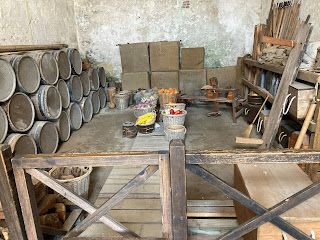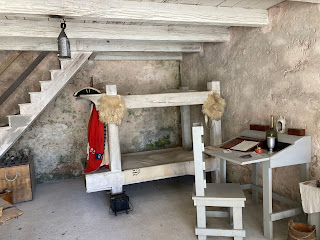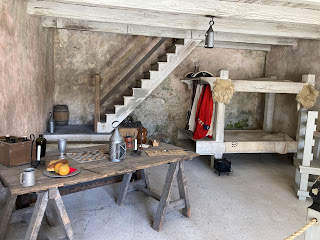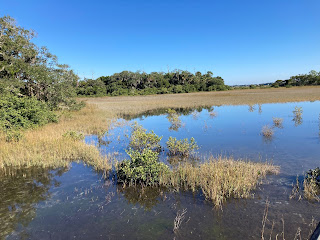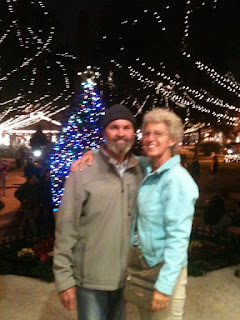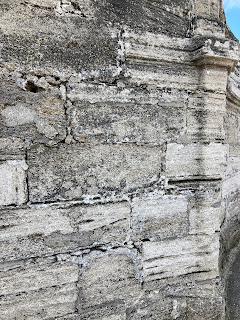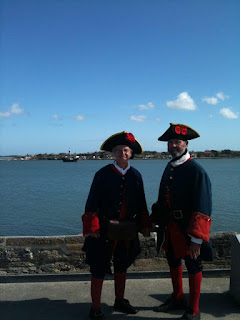Once again we find ourselves temporarily living on land. We had several very practical reasons to be off the boat for a while. Being reluctant to face a second Maryland winter aboard was one, and this winter promised to be snowier and colder than the last one. Also we were needing a place for Dan to recover from the FUS treatment. We had been were warned that the treatment could affect balance for a while after, and though luckily that phase passed quickly, we hadn't known that at the time. And when you're having balance issues, stepping from an icy dock onto a moving sailboat is probably not the best option. We'd been a bit disillusioned with the suburban location at the marina anyway – too far away to easily, spontaneously participate in the cultural opportunities of downtown; and yet not far enough away to give us the restfulness of pristine nature. We sort of had the worst of both in a car-centric location. (Funny bit of trivia – birds in suburbia chirp louder than forest birds, due to having the sound competition of cars and lawnmowers and trash trucks and other suburban conveniences.) And then, at exactly the right time for us, an opportunity presented itself of a cool place to rent, 10 minutes drive away from the boat and 15 minutes walk to downtown.
But in addition to the practical reasons, we were also feeling an increasing need to hit a giant reset button and sift through our possessions again. In every single category it felt like we had Just. Too. Much. “Our boat is choking on our stuff!” Dan complained. It was true. There wasn't a single locker that wasn't packed with absolutely all it could hold. (Hey, no worries about things shifting and breaking if we are rocked by a wave! Things are absolutely jammed in, holding each other in place, no where to go!) Getting anything out required taking three other things out first, then carefully putting everything back in precisely the right order, interlocking. It was psychologically exhausting and the lack of air flow around things made it a more likely breeding ground for mold.
So what had first started as a hurricane evacuation necessity for us years ago has since become a regular practice of emptying all our stuff to somewhere and sorting it into what needs to stay aboard and what goes into storage. Hard to believe after our trip with Big Yellow Truck little more than a year ago we were feeling the need to do it again, but it seemed that was the case, so we were off and packing.
And the weirdest thing happened – all our stuff fit smoothly, comfortably into the rental. That sounds unsurprising … until you realize that our stuff shouldn't have fit. We lived on a 33-foot sailboat. We were moving into a 1000-square-foot apartment. There should have been tons and tons and tons of space left over. But there wasn't.
Our kitchenware spread out and filled an ordinary smallish land-based kitchen. Granted that things were spread out more than they were aboard, and hence were easier to access, but still, they “shouldn't” have needed that much space. There was an entire drawer with a silverware organizer instead of a small tube that held our forks and knives and spoons all together in one end of a small drawer, and a crock next to the stove for tools instead of aligning them in the other side of that same drawer. Our canisters of rice and beans neatly filled a couple of pantry shelves instead of being carefully tucked under the heavy electric wire that ran along the top of a locker to power the windlass. It wasn't difficult to put everything in its place, it was just surprising that we had so much. How had we ever gotten it all into the boat to begin with? No wonder we felt choked!
Our clothing fit in the dressers; there was enough room around everything to put things away easily. But I would have expected whole empty drawers left over after we'd put our things in, which didn't happen. Our books didn't over-fill the book shelves, but they filled them. Et cetera, et cetera. The end result was an apartment that felt comfortable and calm, certainly not stuffed but not minimal either. And a lot of head scratching – how had all this ever fit onto the boat to begin with???
Sorting, decluttering, streamlining, minimizing – we've got our winter's work cut out for us. The hope is to use the space in the apartment to (once again) rethink what we have, and when we do move back aboard to do it with less accumulation.
The furniture, of course is not included in what feels like our glut of possessions. On the boat, everything was built in, so on land we needed to source a desk, a bed, a table, some chairs, etc. It was fun to revisit things we had packed away 20 years ago, when we thought we'd only be cruising for a few years before moving on to the next fun thing, and realize we still liked the choices we had made back then.
We “shopped” from the items we had in storage to furnish the apartment. It was quite the guessing game to figure out which lumpy piece, meticulously wrapped in padded moving blankets, was which. And it was stunningly unhelpful to find boxes that some mover had written “picture” with a black sharpie. Um, yes, thanks, I can see that, since the box is pre-printed with a label that says “glass, picture, do not lay flat” on all sides. (But it really would have helped to have known if it was a picture that came from the living room, or the office, or the bedroom.) My favorite was a 7-foot roll labeled “rug.” Not quite sure what else it could have been mistaken for…
We felt like the apartment was set up, but Dan pointed out what was all around us but had not been acknowledged. We had “moved in,” but not really settled in. We were just here temporarily. We never hung artwork. We never unpacked our very most precious antique furnishings, favorite lamps, Grandma's quilts. Partly that was by design, to keep the calm, light, minimalist vibe the apartment seemed to require. A spiritual friend who visited said she felt a very light aura, but whether that was the ghost of the former owner or our decorating style or both she couldn't say. To me artwork on the walls draws the eye, defines the mood, and also is an anchor that grabs the eye and stops its flow, demanding attention. The blank walls, on the other hand, gave nothing for the eyes to purchase, just glided past, receded. But also, “We've never really taken ownership of this place,” Dan observed. We don't want to, I think. If we really move in, surrounded by things that have deep meaning for us, would it be the first step toward transitioning off the boat and back to land-life, our adventuring done as we approach old age? Or even simply harder to uproot ourselves again at the end of winter? We do like the in-unit washing machine, and the solidity. The apartment doesn't rock in the wind like the boat does. In fact, we barely notice the weather outside, wind or rain or cold, with a massive system to keep the temperature constant. Better not to get too comfortable, because for all its rewards our life afloat does require some sacrifices. For now we are in a fabulous apartment in a superb location … and we can't wait to get back to the boat. C'mon spring!







